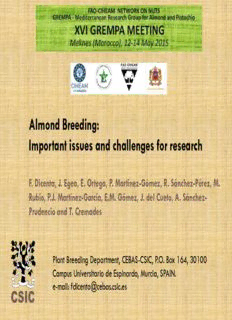
Almond Breeding: Important issues and challenges for research Dr. Federico Dicenta PDF
Preview Almond Breeding: Important issues and challenges for research Dr. Federico Dicenta
Almond Breeding: Important issues and challenges for research F. Dicenta, J. Egea, E. Ortega, P. Martínez-Gómez, R. Sánchez-Pérez, M. Rubio, P.J. Martínez-García, E.M. Gómez, J. del Cueto, A. Sánchez- Prudencio and T. Cremades Plant Breeding Department, CEBAS-CSIC, P.O. Box 164, 30100 Campus Universitario de Espinardo, Murcia, SPAIN. e-mail: [email protected] CSIC Why breed almonds? Solve problems by releasing new cultivars California and Australia: High productivity. Mediterranean countries: Low productivity. Lost of production by frost. Problems during pollination. Rainfeed culture or low irrigation. Cultivar situation California: Nonpareil (40%), Carmel, Butte, Monterrey, etc. Australia: Nonpareil (50%), Carmel, Prize. Mediterranean and other contries: A lot of authoctonous cultivars. New cultivars from breeding programs: Late blooming Self-compatible Results of breeding programs: the “new” cultivars INRA CITA IRTA CEBAS-CSIC USA Ferragnès Ayles Francolí Antoñeta Avalon Ferraduel Guara Masbovera Marta Carmel Lauranne Moncayo Glorieta Penta Butte Mandaline Blanquerna Vayro Padre Cambra Constantí Price Felisia Marinada Sonora Soleta Tarraco Sweetheart Belona Winter Mardía Independence Vialfás Folsom Other important results: scientific research Genetic control: Quantitative traits: Flowering, Maturity,… Qualitative traits: Self-compatibility, Bitterness. Floral biology: Self-incompatibility. Solid orchards with self-compatible cultivars. Molecular markers: Identification of cultivars (SSRs). Early selection (locus S). Other informations: Resistance, quality, etc.. Some practical examples for breeding Predicting the values of seedlings. Most of quantitative traits have high h2. Assuring self-compatibility in the offspring. SfSf, sharing Si-allele, self-pollination. Avoiding bitter seeded seedlings. Use of homozygous SS. Early selection of self-compatible seedlings. PCR allele specific of S-locus. Early selection of self-compatible seedlings Biotechnological advances: Marker Assisted Selection G1 G2 G3 G4 G5 G6 G7 G8 0 CPPCT027 0 UDP98-025 0 UDP97-403 0 BPPCT010 0 BPPCT026 0 CPPCT008 0 CPPCT022 0 BPPCT033 2 BPPCT007 2 CPPCT035 4 CPDCT047 6 UDP97-401 7 UDP96-005 7 BPPCT004 7 UDP96-019 SSShhhwww--- QQQ 111 9 pchgms2 9 UDP98-405 10 BPPCT002 10 BPPCT039 11 UDP98-408 12 UDP96-001 14 CPPCT028 14 CPPCT006 17 UDP96-013 17 BPPCT029 18 BPPCT021 18 UDP98-024 18 PS1H3 SSShhhwww ---QQQ 222 DDD-Q 21 BPPCT017 22 CPPCT002 22 BPPCT008 23 UDP97-402b 23 UDP98-407 26 UDP98-411 28 CPPCT026 28 Sk 28 CPPCT033 30 UDP96-008 30 PceGA025 31 PMS67 31 UDP97-402a Lb P- Q 34 MA027a Dk- Q Lf- Q 2 EPDCU4658 37 UDP96-003 38 EPDCU5183 Kw- Q 2 39 BPPCT038 39 BPPCT025 KKKwww--- QQQ 111 42 UDP98-409 43 UDP98-410 LLLfff--- QQQ 111 46 CPDCT027 46 UDP98-021 48 BPPCT011 48 EPDCU3392 50 BPPCT014 53 pchcms3 55 UDP98-406 56 S 58 CPPCT030 Simulation of early selection 1.000 seedlings Self-compatibility Self-incompatible Self-compatible (Sx,Sf x SySz) 500 500 Bitternes Bitter Sweet Bitter Sweet (Ss x Ss) 125 375 125 375 Flowering time <x >x <x >x <x >x <x >x (> or < mean population) 63 63 188 188 63 63 188 188 Selection of seedlings in the orchard Flowering Productivity Fruits traits
Description: